Вы не зашли.
Объявление
"Давайте только проявлять больше внимания, терпимости и уважения к чужому мнению — вот и всё." — Gennadius.
— О размещении изображений на форуме, О рекламе на форуме
#1151 21 February 2012 09:23:49
- Dinofelis
- Без пяти минут зоолог

- Откуда: Чёрные Земли
- Зарегистрирован: 13 November 2010
- Сообщений: 1721
Re: Саблезубые кошки (Machairodontinae)

А разве в Южной Америке гомотерия не находили?
Извиняюсь, дочитал статью до конца, про венесуэльские находки есть, только на карте не отмечены.
Отредактировано Dinofelis (21 February 2012 09:26:02)
Как страшно жить.
Неактивен
#1152 21 February 2012 10:22:11
- Юра
- Без пяти минут зоолог
- Зарегистрирован: 31 July 2008
- Сообщений: 10735
Re: Саблезубые кошки (Machairodontinae)
Dinofelis :
про венесуэльские находки есть, только на карте не отмечены.
На очень ценном сайте Paleobiology Database, откуда и скопирована карта находок, зачастую есть инфа о многих, но не о всех местонахождениях. До венесуельского, видимо, у них еще не дошли руки.
Неактивен
#1153 21 February 2012 11:06:00
- Сorvin
- Модератор
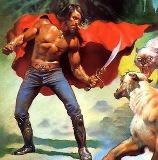
- Откуда: Двор Хаоса
- Зарегистрирован: 28 December 2009
- Сообщений: 5921
Re: Саблезубые кошки (Machairodontinae)
Mea culpa, спасибо, из виду совсем выпустил, исправить недолго. Просто не хотел отягощать статью излишней инфой, которую особо читать никто не будет - к примеру: более подробные карты местонахождений; фаунистические комплексы хищников плиоцен-плейстоцена, в которых существовал гомотерий; взаимоотношения махайродонтид с гоминидами; опустил ряд размерных таблиц, сделав упор на рассмотрение морфологических особенностей и предполагаемой этологии. А у тех, кого вышеописанное действительно интересует, оно давно в наличии имеется.
В палеонтологии отрицательный результат ещё ничего не значит.
Леон Берген
Неактивен
#1154 21 February 2012 15:14:56
- shish02
- Гость
Re: Саблезубые кошки (Machairodontinae)
Сorvin :
Статья о гомотерии в ВМ:
http://age-of-mammals.ucoz.ru/index/homotherium/0-534
Большое спасибо Андрею за помощь в написании, Глебу - в корректировке, Юре - в оформлении статьи.
Доброе дело и большая работа. Игорь, посмотри почту.
#1155 23 February 2012 03:17:33
Re: Саблезубые кошки (Machairodontinae)
Если прайд львов так эффективно охотится на бегемотов, то можно смоделировать и охоту саблезубых, если они жили тоже прайдом, но в этом случае охота саблезуба будет на порядок эффективней!!
http://www.youtube.com/watch?v=5vl9F4NO … re=related
Неактивен
#1156 08 April 2012 14:49:40
- Crazy Zoologist
- Гость
Re: Саблезубые кошки (Machairodontinae)
И за это говорит узкий саблезубый клык
Клык далеко не самого крупного саблезуба мегантереона толще, чем у медведя, чей череп крупнее мегантереоновского.
#1157 09 April 2012 02:30:11
- Crazy Zoologist
- Гость
Re: Саблезубые кошки (Machairodontinae)
А посткраниальный скелет динофелиса относительно массивнее современных пантер? Если да, то массу его тела я оцениваю примерно в 180 кг.
#1158 13 May 2012 05:12:00
- Crazy Zoologist
- Гость
Re: Саблезубые кошки (Machairodontinae)
Относительно того, что у саблезубых кошек клыки были тоньше, чем у несаблезубых хищников:
Толщина верхних клыков грузинского мегантереона - 1,2 см. У гомотерия кренатиденса - 1,4 см.
У динофелиса - 1,5 см. Ширина - 2,5 см. При этом длина черепа грузинского мегантереона - 23,7 см. К слову, длина черепа этрусского волка - 22, 9 см, а ширина в скулах - 11,6 см. Мой показатель длины черепа динофелиса отличается от того, который приведен в работах относительно грузинского экземпляра. Мой показатель - 32 см. Ширина в скулах - около 20 см. Длина верхнего левого клыка (коронки) - 6,5 см, точнее не длина, а высота, длина получится чуть больше.
Я сравнивал толщину клыков этих кошачьих с толщиной клыков у черепов кавказских медведей. Там черепа были не более 30 см в длину, ну может самый крупный был 30 с хвостиком. Так вот, я взял один из самых крупных черепов и измерил толщину верхнего клыка - 1,1 см. То есть меньше, чем и у гомотерия, и у динофелиса и даже меньше, чем у мегантереона.
#1159 13 May 2012 20:21:17
- Crazy Zoologist
- Гость
Re: Саблезубые кошки (Machairodontinae)
Source: A. R. Biknevicius; B. Van Valkenburgh; J. Walker; Incisor size and shape: implications for feeding behaviors in saber-toothed “cats”; Journal of Vertebrate Paleontology;
Volume 16, Issue 3, 19 September 1996, Pages 510 - 521
Canids and Sabertooths Have Strongest Incisors
Below is data showing incisor strength in comparison to body size. The first chart gives the bending strength of I1 and I2, the medial incisors or incisors furthest from canines, of numerous extant canids, felids, hyenas, and extinct conical and sabertooth felids. Since incisor strength increases with larger body size, this data should be compared based on similar body sizes. The study uses occipito-orbital length ("OOL"), which is a measure of skull length excluding the snout, and is highly correlated with body size. OOL for the species is listed in the second table. The third chart below graphs anterioposterior I2 bending strength from the first chart against OOL from the second chart (my graph using study data). The trend line is the average of all species and species to the left and above trend line have stronger incisors.
Some key observations:
Canids > hyenas > extant felids in incisor bending strength at similar sizes.
Sabertooths > incisor strength than extant felids at similar sizes
The wolf, AWD, hoplophoneus, and homotherium have the strongest incisors for their body size
Lions have stronger incisors than tigers for their body size
Jaguars have strongest incisors for their body size in extant cats
Clouded leopards have weaker incisors grouping with extant rather than sabertooth cats
Coyote surprisingly had slightly stronger incisors than the dhole. However, dholes have proportionally larger heads than coyotes so dhole may have weighed less than coyote given similar OOL or skull size.
Bobcat and pseudaelurus have very weak incisors for their body size

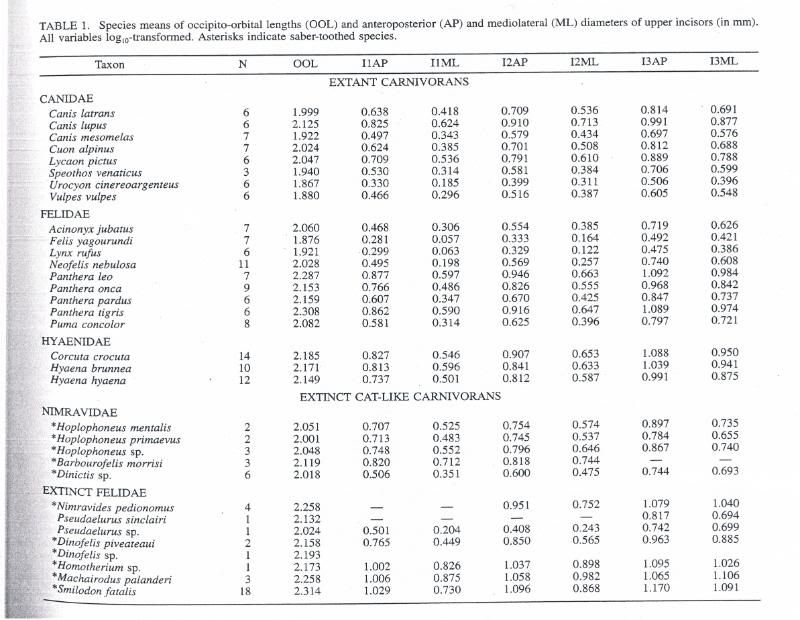
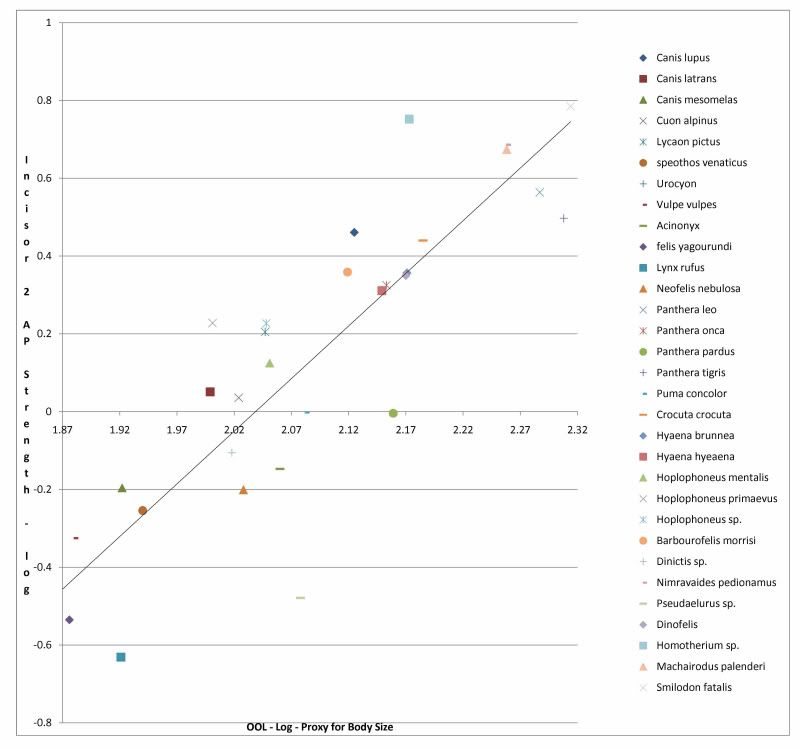

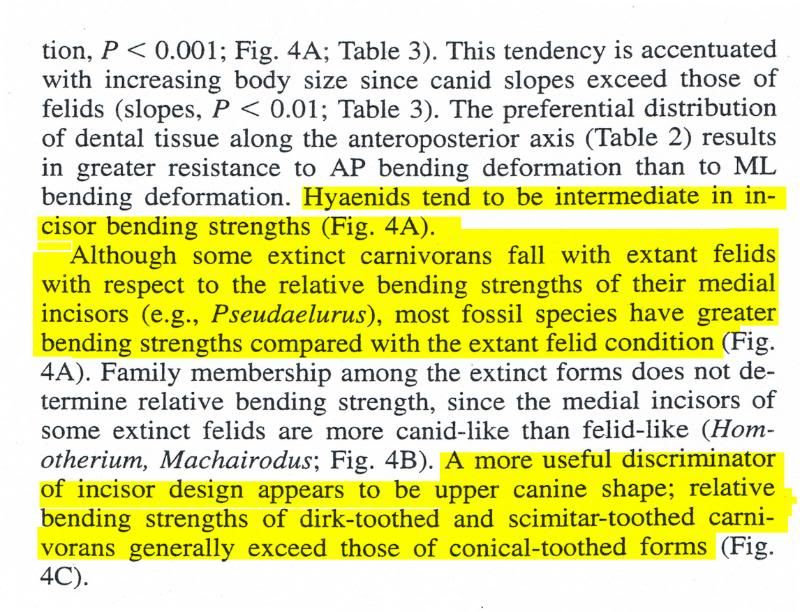
In addition, the authors also use another measure of incisor robustness, cross-sectional area or shear strength, and have similar findings. The graph below shows I3 (incisor next to canine) and I2 (incisor between I3 and I2) cross-sectional area or shear strength plotted against OOL. I3 is stronger than I2 in all species since I3 does not receive as much support from adjacent incisors as I2 and therefore must be stronger. Canid incisors generally exceed hyenas who generally exceed extant felids in shear strength. Sabertooth incisors generally exceed extant felids in shear strength, but are generally below extant canids. Homotherium, Hoplophoneus, Barbourofelis morrissi, and Dinofelis score high for extinct felids and have large incisor cross-sectional areas.
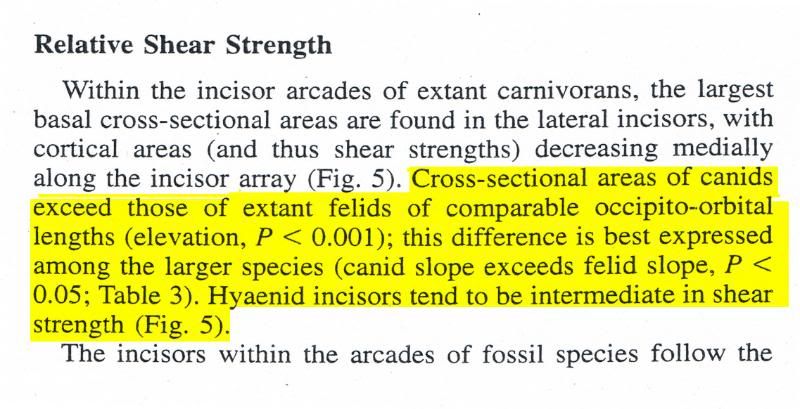


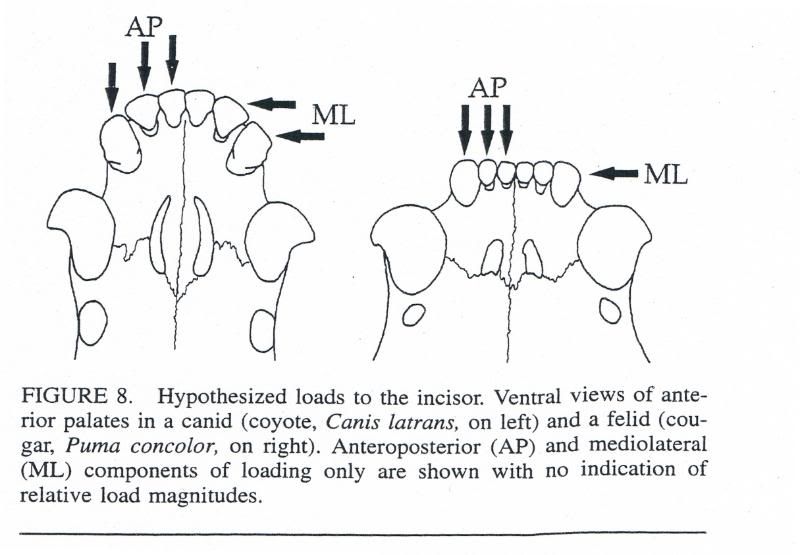
Unfortunately, the curvature of extant families, but not most extant species, is provided in this study. However, the gray fox is mentioned as having the most curved incisor arrangement while the jaguar has the least curved arrangement. Also, the CL is mentioned as having a less curved incisor arrangement and the lion has the most curved incisor battery of extant felids.While the gray fox could theoretically produce a large bite wound, this is offset by its very weak incisors and bite. Similarly, the jaguar would produce a smaller wound for its size, but its strong incisors and powerful bite allow it to inflict devastating injuries. These are good examples to remember to consider this data in conjunction with other information.
The following graph (parts A and B) illustrates the incisor battery curvature for extant canid, hyena, and felid families along with extinct felid and nimravid species. As the graph shows, canids have the most curved incisors arrangements followed by hyenas and extant felids. Hoplophoneus and Barbourofelis morrissi have the most curved incisors batteries among extinct felids and nimravids.



#1160 13 May 2012 20:23:23
- Crazy Zoologist
- Гость
Re: Саблезубые кошки (Machairodontinae)
Incisor Strength and Battery Curvature Summary
The graphs below summarize the results from above. The figure on the left measures incisor battery curvature which is a metric of jaw dexterity and ability to inflict large wounds. Species on the left ("PC1"), such as canids, have the most jaw dexterity and produce the largest wounds for their body size. Hoplophoneus, Barbourofelis and an outlying Dinofelis specimen have the most jaw dexterity and produce the largest wounds at parity among extinct species.
The figure on the right summarizes both incisor strength and incisor curvature. Think of this graph as the ability to "grapple with the mouth" as it indicates ability to hold and restrain prey and produce large wounds. However, other factors also impact this, such as bite force, jaw, and skull strength. Species near the top ("PC2") "grapple with their mouth" the best all else being equal. Canids score the highest among extant species. Barbourofelis morrisi, Hoplophoneus, and Dinictis appear to grapple with their mouth the best among extinct felids. Note that sabertooth species likely had other offsetting factors which reduced the ability to grapple with their mouth, such as weak bites and skulls.
Canid Incisors Function as a Grasping Organ Performing a Similar Role as Felid Forelimbs
The excerpt below discusses the critical role incisors play for canids when they "grapple with their mouth." Big cats typically have stronger canines than canids, but canids compensate by using their incisors to limit the motion of prey and therefore reducing stress on the canines. In addition, felids may have smaller incisors to increase canine penetration in prey. Thus, canid jaws are more adapted for grasping while felid jaws appear more adapted for deep penetrating bites.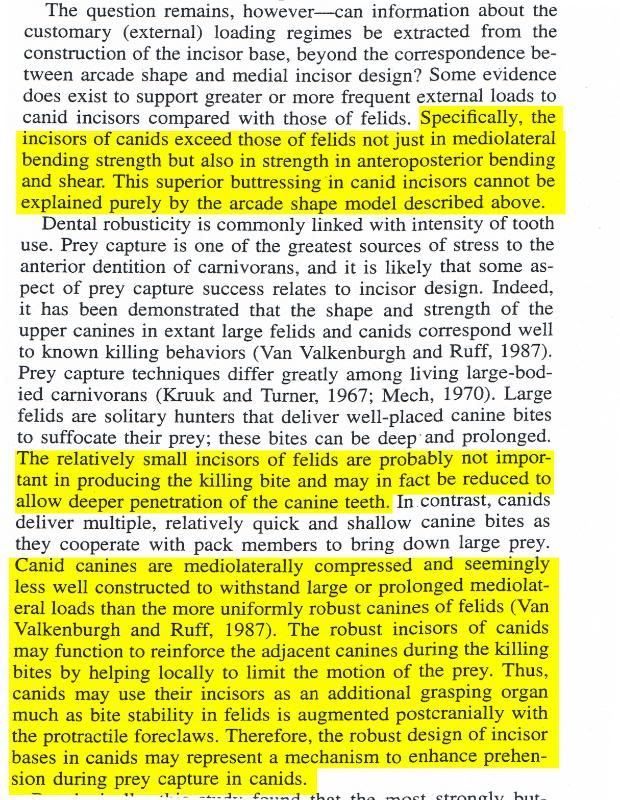
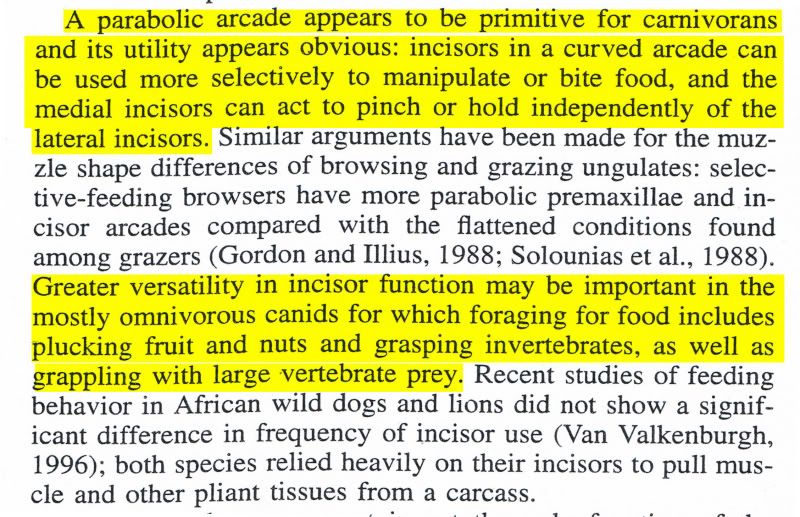

Strong Incisors in More Curved Arrangements Allowed Sabertooths to Restrain Prey with Their Mouths to Kill with "Canine Shear Bite"
The excerpt below discusses how sabertooth species used their incisors to help restrain prey and produce massive wounds. Strong incisors in curved arrangements helped restrain prey, along with powerful forelimbs, and the curved incisor battery along with the canines produced a massive and devastating wound in the "canine shear bite" to the throat.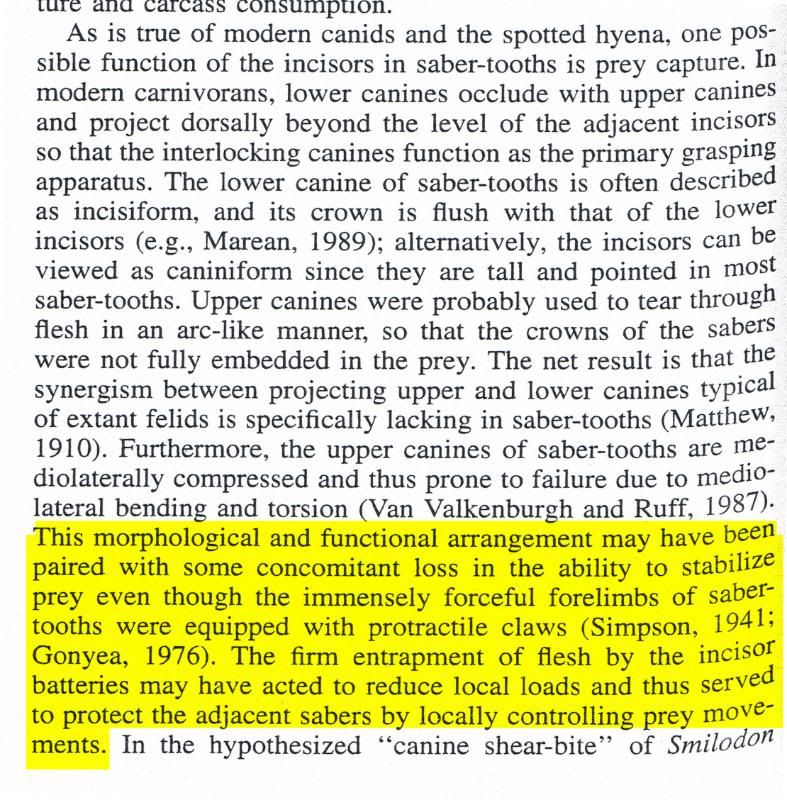
#1161 13 May 2012 20:29:50
- Crazy Zoologist
- Гость
Re: Саблезубые кошки (Machairodontinae)
Ареал распространения динофелиса:
#1162 13 May 2012 21:34:50
- shish02
- Гость
Re: Саблезубые кошки (Machairodontinae)
Кот :
Ареал распространения динофелиса:
http://upload.wikimedia.org/wikipedia/c … _range.png
А куда делась Северная Америка?
#1163 13 May 2012 21:37:47
- shish02
- Гость
Re: Саблезубые кошки (Machairodontinae)
Да + еще Индия
#1164 14 May 2012 01:17:15
- Crazy Zoologist
- Гость
Re: Саблезубые кошки (Machairodontinae)
Наверное имелся в виду какой-то определенный вид.
#1165 15 May 2012 00:12:13
- Сorvin
- Модератор

- Откуда: Двор Хаоса
- Зарегистрирован: 28 December 2009
- Сообщений: 5921
Re: Саблезубые кошки (Machairodontinae)
shish02 :
Да + еще Индия
+Пакистан (Сивалик)
и далее:
+ Китай (Хэнань) - Dinofelis abeli (D. cristata)
+ Этулия (Гагаузия) - на карте тоже не захвачено, хотя, как я понял, на карте - объединённые предполагаемые ареалы D. barlowi, D. cristata и D. diastemata
В палеонтологии отрицательный результат ещё ничего не значит.
Леон Берген
Неактивен
#1166 15 May 2012 00:22:56
- Сorvin
- Модератор

- Откуда: Двор Хаоса
- Зарегистрирован: 28 December 2009
- Сообщений: 5921
Re: Саблезубые кошки (Machairodontinae)

Географическое распределение ископаемых находок рода Dinofelis. Цифрами обозначены: 1 - Хадар; 2 - средний Аваш и Консо-Гардула; 3 - бассейн Туркана (Омо, залив Аллия, Канапои, Куби Фора, Лотегем , Накорет, Западный Туркана); 4 - восточный Канам; 5 - местоположения долины Стеркфонтейн (Болтс Фэрм, Глэдисваль , Кромдраай, Стеркфонтейн, Сварткранс); 6 - Лангебаанвег; 7 - Макапансгат; 8 - Лаэтоли и Олдувайское ущелье; 9 - Хэнань; 10 - Сиваликские холмы; 11 - Бэларук и Сьерра-ден-Ваккувэр; 12 - Вента дель Моро; 13 - Мелаани; 14 - Этулия; 15 - Бланко.
В палеонтологии отрицательный результат ещё ничего не значит.
Леон Берген
Неактивен
#1167 15 May 2012 21:52:06
- Crazy Zoologist
- Гость
Re: Саблезубые кошки (Machairodontinae)


Ксеносмил.
Какие короткие ступни у него...
Парамахайрод.
rom left to right: Hoplophoneus Occidentalis - Barbourofelis Fricki - Panthera Leo Atrox - Homotherium (serum?)



Супер-рисунок ксеносмила!:-)

И заодно нимравус.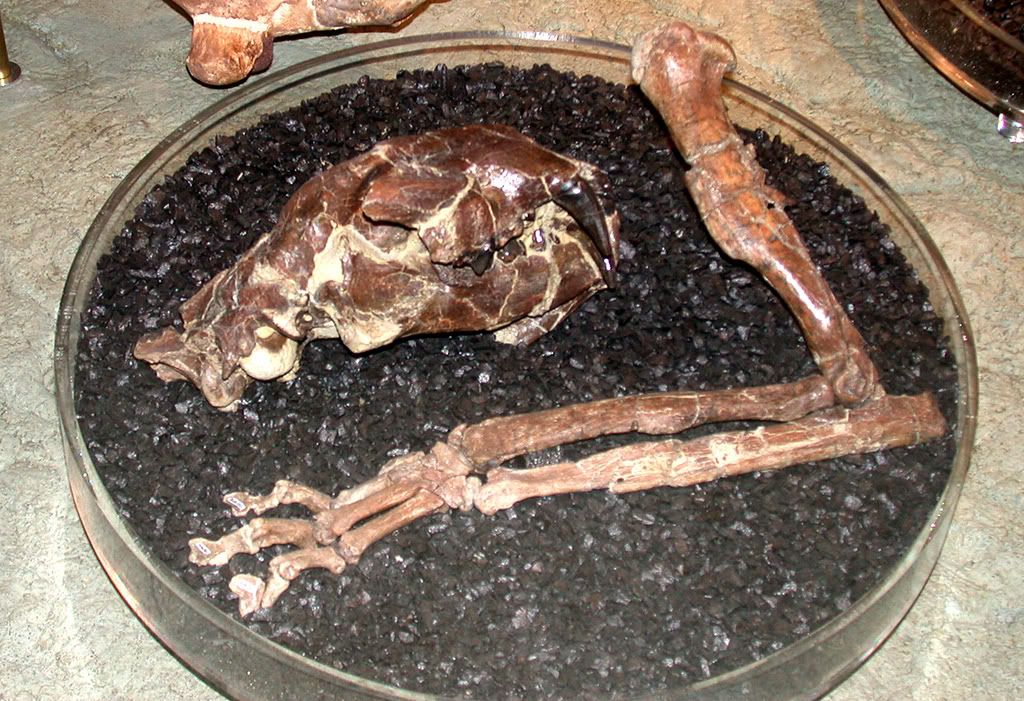

#1168 15 May 2012 22:10:02
- Crazy Zoologist
- Гость
Re: Саблезубые кошки (Machairodontinae)
По поводу гораздо более слабого сжатия челюстей саблезубых достаточно взглянуть на это фото:
From Left to right upper part Smilodon Fatalis, Machairodus Giganteus, Panthera Leo Atrox. - Second row: Siberian Tiger and African Lion. - Third Row: Jaguar, Jaguar, African Leopard and Clouded Leopard. - Four Row: Puma, Puma, Ocelot and Ocelot.
#1169 16 May 2012 08:48:35
- Dinofelis
- Без пяти минут зоолог

- Откуда: Чёрные Земли
- Зарегистрирован: 13 November 2010
- Сообщений: 1721
Re: Саблезубые кошки (Machairodontinae)
shish02 :
Кот :
Ареал распространения динофелиса:
http://upload.wikimedia.org/wikipedia/c … _range.pngА куда делась Северная Америка?
Да там вообще карта мира без Америки - мечта Задорнова ![]()
Как страшно жить.
Неактивен
#1170 16 May 2012 15:08:01
- Сorvin
- Модератор

- Откуда: Двор Хаоса
- Зарегистрирован: 28 December 2009
- Сообщений: 5921
Re: Саблезубые кошки (Machairodontinae)
АртёмСаныч, спасибо, пара фоток действительно интересны.
Только знаешь, шо скажу - реконструкции мышечной системы не очень достоверны, можно поспорить. Сам взгляни - массетерная мышца, как одна из доминирующих в краниали, обозначена слабо и, мало - того - вообще-то, она пролегает над костями.
В палеонтологии отрицательный результат ещё ничего не значит.
Леон Берген
Неактивен
#1171 16 May 2012 16:11:09
- Crazy Zoologist
- Гость
Re: Саблезубые кошки (Machairodontinae)
Скорее всего не анатом картинку делал.
#1172 17 May 2012 02:38:40
- Crazy Zoologist
- Гость
Re: Саблезубые кошки (Machairodontinae)
Игорь, а тут?
#1173 23 May 2012 22:27:23
- Crazy Zoologist
- Гость
Re: Саблезубые кошки (Machairodontinae)
По кольцам на клыках саблезубов можно определить их возраст.
#1174 24 May 2012 18:32:43
- Алекс
- Сан Саныч - Модератор

- Откуда: Юг Украины
- Зарегистрирован: 05 February 2008
- Сообщений: 24254
Re: Саблезубые кошки (Machairodontinae)
A revision of the genus Dinofelis (Mammalia, Felidae) http://onlinelibrary.wiley.com/doi/10.1 … aintenance
" Из говна настоящий бульдог не получится, а вот силуэт слепить можно ". "Отрицать прошлое — это отрицать себя "
Неактивен
#1175 11 June 2012 21:34:16
- Левша
- Любитель животных

- Зарегистрирован: 19 December 2010
- Сообщений: 709
Re: Саблезубые кошки (Machairodontinae)
Перевод статьи ''Hodnett J-P, 2010. A Machairodont felid (Mammalia; Carnivora; Felidae) from the latest Hemphillian (Late Miocene/Early Pliocene) Bidahochi Formation, northeastern Arizona. PaleoBios,29(3)'' от Андрея
Ходнетт 2010. Махайродонт из позднехемфильской формации Бидахочи.pdf
Загрузка рисунков http://savepic.net/index.php
Неактивен
